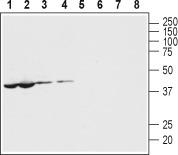Pannexin 1 (PANX1) Rabbit Polyclonal Antibody
Other products for "PANX1"
Specifications
| Product Data | |
| Applications | IHC, WB |
| Recommended Dilution | WB: 1:200-1:2000; IHC: 1:100-1:3000 |
| Reactivities | Human, Mouse, Rat |
| Host | Rabbit |
| Clonality | Polyclonal |
| Immunogen | Peptide (C)KEPTEPKFKGLRLE, corresponding to amino acid residues 18- 31 of human Pannexin 1 . Intracellular, N-terminus. |
| Formulation | Lyophilized. Concentration before lyophilization ~0.8mg/ml (lot dependent, please refer to CoA along with shipment for actual concentration). Buffer before lyophilization: phosphate buffered saline (PBS), pH 7.4, 1% BSA, 0.05% NaN3. |
| Purification | Affinity purified on immobilized antigen. |
| Conjugation | Unconjugated |
| Storage | Store at -20°C as received. |
| Stability | Stable for 12 months from date of receipt. |
| Gene Name | pannexin 1 |
| Database Link | |
| Background | Gap junctions are usually found in clusters and enable intercellular communication by allowing the passage of small molecules between cells. They play important roles in different biological processes. These include differentiation, cell cycle synchronization, cellular development, neuronal activity and the immune response. Proteins involved in gap junction formation are composed of four transmembrane domains, 2 extracellular loops and one intracellular loop and intracellular N- and C-termini. Several consensus cysteine residues are in the extracellular loop and are essential and necessary for intercellular docking of gap junction hemichannels in the opposing cell membrane. Pannexins (Pannexin 1, Pannexin 2 and Pannexin 3) belong to the superfamily of gap junction proteins. Pannexin 1 (PANX1) is ubiquitously expressed, Pannexin 2 (PANX2) is specifically expressed in the human brain and widespread in rodents and Pannexin 3 (PANX3) is also detected in the brain. The gating properties of Pannexins were studied in Xenopus oocytes and results demonstrate that only PANX1 is able to form homomeric hemichannels, and is also able to form heteromeric hemichannels with PANX2 but not with PANX3. Not surprising, PANX1 gating properties depend whether it forms homomeric or heteromeric hemichannels. A number of different stimuli are known to open these channels and include mechanical stress, extracellular ATP, increases in intracellular Ca2+ and inflammation. Possible roles for Pannexins include paracrine signaling in vascular endothelial cells and taste cell signaling. |
| Synonyms | MRS1; PX1; UNQ2529 |
| Reference Data | |
| Protein Families | Transmembrane |
Documents
| Product Manuals |
| FAQs |
{0} Product Review(s)
0 Product Review(s)
Submit review
Be the first one to submit a review
Product Citations
*Delivery time may vary from web posted schedule. Occasional delays may occur due to unforeseen
complexities in the preparation of your product. International customers may expect an additional 1-2 weeks
in shipping.






























































































































































































































































 Germany
Germany
 Japan
Japan
 United Kingdom
United Kingdom
 China
China




